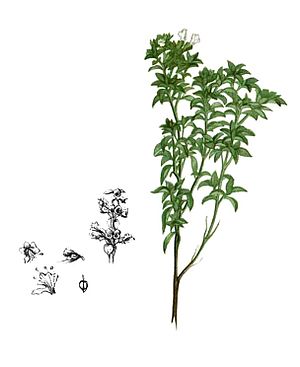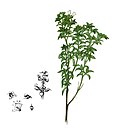Note: This is a project under development. The articles on this wiki are just being initiated and broadly incomplete. You can Help creating new pages.
Difference between revisions of "Ocimum canum"
| Line 1: | Line 1: | ||
[[File:Ocimum canum Blanco2.257.jpg|thumb|right]] | [[File:Ocimum canum Blanco2.257.jpg|thumb|right]] | ||
| + | '''Ocimum Canum''' belongs to the Lamiaceae family. This annual plant is native to the African continent and grows to a height of 2 feet. It is also known as the African basil with a distinct mint flavor, with hairy leaves and scented flowers. | ||
==Uses== | ==Uses== | ||
{{Uses|Colds}}, {{Uses|Fevers}}, {{Uses|Parasitic infestations}}, {{Uses|Headaches}}, {{Uses|Inflammation of joints}}, {{Uses|Dysentary}}, {{Uses|Tooth problems}}.<ref name="Uses"/> | {{Uses|Colds}}, {{Uses|Fevers}}, {{Uses|Parasitic infestations}}, {{Uses|Headaches}}, {{Uses|Inflammation of joints}}, {{Uses|Dysentary}}, {{Uses|Tooth problems}}.<ref name="Uses"/> | ||
Revision as of 16:20, 8 June 2020
Ocimum Canum belongs to the Lamiaceae family. This annual plant is native to the African continent and grows to a height of 2 feet. It is also known as the African basil with a distinct mint flavor, with hairy leaves and scented flowers.
Contents
- 1 Uses
- 2 Parts Used
- 3 Chemical Composition
- 4 Common names
- 5 Properties
- 6 Habit
- 7 Identification
- 8 List of Ayurvedic medicine in which the herb is used
- 9 Where to get the saplings
- 10 Mode of Propagation
- 11 How to plant/cultivate
- 12 Commonly seen growing in areas
- 13 Photo Gallery
- 14 References
- 15 External Links
Uses
Colds, Fevers, Parasitic infestations, Headaches, Inflammation of joints, Dysentary, Tooth problems.[1]
Parts Used
[[:Category:Herbs with used in medicine|]], stem, leaves, Root.
Chemical Composition
Common names
| Language | Common name |
|---|---|
| Kannada | |
| Hindi | |
| Malayalam | |
| Tamil | |
| Telugu | |
| Marathi | |
| Gujarathi | |
| Punjabi | |
| Kashmiri | |
| Sanskrit | |
| English |
Properties
Reference: Dravya - Substance, Rasa - Taste, Guna - Qualities, Veerya - Potency, Vipaka - Post-digesion effect, Karma - Pharmacological activity, Prabhava - Therepeutics.
Dravya
Rasa
Guna
Veerya
Vipaka
Karma
Prabhava
Habit
[[:Category:Habit - |]]
Identification
Leaf
| Kind | Shape | Feature |
|---|---|---|
Flower
| Type | Size | Color and composition | Stamen | More information |
|---|---|---|---|---|
| {{{5}}} |
Fruit
| Type | Size | Mass | Appearance | Seeds | More information |
|---|---|---|---|---|---|
Other features
List of Ayurvedic medicine in which the herb is used
Where to get the saplings
Mode of Propagation
[[:Category:Index of Plants which can be propagated by |]]
How to plant/cultivate
It flourishes in conditions of lot of sun, well drained soils and access to heat.[4]
Commonly seen growing in areas
[[:Category:Herbs that are commonly seen in the region of |]], [[:Category:Herbs that are commonly seen in the region of |]], [[:Category:Herbs that are commonly seen in the region of |]], [[:Category:Herbs that are commonly seen in the region of |]], [[:Category:Herbs that are commonly seen in the region of |]].
Photo Gallery
References
External Links
- Ayurvedic Herbs known to be helpful to treat Colds
- Ayurvedic Herbs known to be helpful to treat Fevers
- Ayurvedic Herbs known to be helpful to treat Parasitic infestations
- Ayurvedic Herbs known to be helpful to treat Headaches
- Ayurvedic Herbs known to be helpful to treat Inflammation of joints
- Ayurvedic Herbs known to be helpful to treat Dysentary
- Ayurvedic Herbs known to be helpful to treat Tooth problems
- Herbs with used in medicine
- Herbs with stem used in medicine
- Herbs with leaves used in medicine
- Herbs with Root used in medicine
- Habit -
- Index of Plants which can be propagated by
- Herbs that are commonly seen in the region of
- Herbs
- Pages without herbs images

